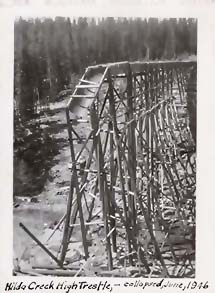History of the BMID
Following is a brief history of events that have shaped the Black Mountain Irrigation District.
Mid 1800’s
In the mid 1850’s the uses for water were limited in the Okanagan Valley, however elsewhere in the province gold mining had caused the need to set out the first rules and regulations for water use. In August, 1859 the “Rules and Regulations for the Working of Gold Mines” was published. Of the twenty-six regulations, nine of them dealt with water. The regulations included who could apply for water, the principle of beneficial use, government regulations of water rates, penalties for wastage of water, right-of-ways for construction, water quality protection, and priority of access to water. Since then the water principles of “beneficial use” and “prior appropriation” were the basis for water law in the province.
1880 to 1920
In the late 1880’s the Okanagan Valley regional economy was based on cattle ranching and the growing of grain crops. Water was being drawn from local sources; however the water laws were not enforced to allow reliable and regulated use of the water for greater benefit of the public. Private water companies and land developers were obtaining water licenses, assigning water rights to local dry lands and selling these lands for a profit with the guarantee of a water supply to those lands.
| The ability to irrigate these lands quickly changed the face of the countryside in the Okanagan. The canals, flumes, siphons and measurement of flow from the watersheds became much more scientific and the companies employed water engineers to design water conveyance works. Between 1904 and 1914, roughly 40,000 acres of land was irrigated between Vernon and Osoyoos. |  |
| Furrow Irrigation in the Early 1900's (Photo Courtesy of the Kelowna Museum) |
In the Black Mountain area in 1904, Rutland Estates commenced intensive development. Water was required for irrigation purposes and was being drawn from Mission Creek. In 1907, the Central Okanagan Land and Orchard Company undertook the subdivision of approximately 1500 acres and constructed a ditch about five (5) miles long to bring water south from Kelowna Creek (Mill Creek).
|
In 1909, the Belgo Canadian Fruit Land Company commenced development of 6,000 acres of land lying east and southeast of the Rutland Estates and Central Okanagan Lands. To irrigate these lands, the company undertook one of the most ambitious projects in the region. They constructed a ditch 14 miles long from Belgo Creek (then called the North Fork of Mission Creek) to Kelowna. The right-of-way and remains of some of the line remains in-place today. |
 |
| Belgo Flume Construction, 1910 (Photo Courtesy of the Kelowna Museum) |
The original irrigation works were generally laid out as open ditch systems. During the period of the First World War, the irrigation works of all three started showing signs of deterioration due mainly to negligence and improper maintenance. It wasn’t until 1914 that the Province first allowed the formation of Public Irrigation Corporations, however with the First World War there was little change in the water supply.
In the late 1910s, although the irrigation companies did not appear to be in serious financial difficulty, it was readily seen that the ratepayers and management structure of the companies was inadequate to bear the whole expense of maintaining the works and that trouble would arise shortly. Urgent system modifications and replacements became necessary. In 1919, the Province of BC set up a $2,000,000 Conservation fund to assist in the public take-over and upgrading of the private water companies.
In the Black Mountain area, it was then suggested that an amalgamation of the three large water systems would best serve their interests. These were the Black Mountain Water Company, the Central Okanagan Land and Orchard Company and Rutland Estates. The private water companies and the orchardists both lobbied the government to allow the formation of Irrigation Districts.
In 1920, the first districts received their letters patent. These included Vernon, Glenmore, Naramata, South East Kelowna and the Black Mountain Irrigation District. The Black Mountain Irrigation District was incorporated under the “Water Act” and received its Letters Patent on November 3rd, 1920. The first meeting of the Black Mountain Irrigation was held on Tuesday, November 23, 1920, and the first board of trustees elected were: C.H. Bond, E.M. Carruthers, E. Mugford, W.R. Reed and S.F. Workman. The Secretary was J.R. Beale. The Engineer was Grote Stirling who constructed and lived in the Belgo Residence near Belgo Pond in 1912.
1920 – 1950
The BMID gravity system was the result of the purchase and amalgamation of the Black Mountain Water Company (subsidiary of the Belgo-Canadian Fruit Land Co.), the Kelowna Irrigation Company, and Rutland Estates. In 1925, BMID also took over the Rutland Drainage Works. The drainage works were necessary as a result of the furrow-type irrigation and relatively flat lands in the valley bottom. The primary source of water was by gravity from the Belgo Creek watershed through the Belgo flume.
Immediate repairs and extensions were required to provide additional storage dams and main canals. The next 20 years showed signs of stability and growth for the water district and agriculture in the Okanagan. There was an extensive amount of maintenance and upkeep on the system but the methods of water supply were consistent and supply was stable.
From 1929 to 1931, the Okanagan experienced a three year drought of a magnitude that has not been experienced since. The three years of drought resulted in the lowest levels of water flowing into Okanagan Lake in recorded history. The impact on BMID was less than in the other water districts as BMID had a higher elevation watershed. The drought impacts were still felt as the demand for water was higher than anything previously experienced.
In 1929, proposed projects included the diversion of water from Hilda Creek into Belgo Reservoir, the addition of planks along the top of the Belgo 66” diameter flume to increase conveyance capacity by 12 cubic feet per second, and the development of a dam at Graystoke Lake located some 40 miles outside of Kelowna near the head of Mission Creek. The drought of the 1930’s passed on and these projects were eventually implemented.
Figure 1 - Total Inflow to Okanagan Lake
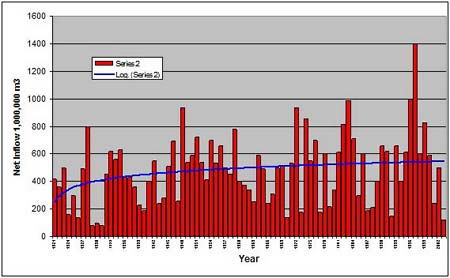 |
Water was assessed to land at an annual rate of 2½ feet per acre. Discussions that took place at board meetings were related to the efficiencies of furrow versus sprinkler systems and the fairness in charging for water. Other issues were the renewal of infrastructure and the safety of the wooden flumes and log cribbing reinforcing the dams.
|
Historic BMID revenue producing acreage 1938 3,700 acres Irrigation Charges and Domestic Water Rates
|
|
In 1949 a low level ditch was being constructed from Mission Creek near Eight-Mile Ranch to Kelowna. The high level ditch was located approximately 200m higher along the slopes of Black Knight Mountain and some of its route and remants can still be seen today.
Also in 1949, Prairie Farm Rehabilitation Administration came in to investigate the installation of a low level balancing reservoir located in the Gopher Flats area in behind Bell Mountain. Since 1949, BMID has had the reservoir in its Capital Plans however has not had to implement construction of the damsite. Subsequent studies for a dam at the site were carried out for BMID in 1967, 1975, 1990 and 1995.
1950 to 1980
|
During the late 1950s, the system continued to age and service the Black Mountain service areas with water primarily for irrigation. During this time, pressure type systems were becoming more common, and in the late 1960’s, funding for the construction of a pressurized water supply system was made possible with the passing of the Agricultural Rehabilitation and Development Act (ARDA). The act allowed costs to be shared equally among BMID, the Provincial and the Federal Governments. |
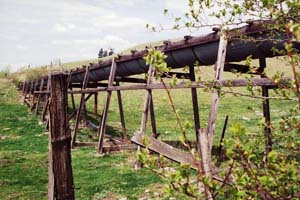 |
Works began in 1968 and continued into the early 1970s. A major pressurized system was designed and constructed in BMID that is the third largest in the Okanagan Valley behind Vernon and Oliver. A more scientific approach to water supply resulted in agricultural mapping of soil types and water requirements being assigned to all lands within the District. In 1969 Fishhawk Dam washed out during a very heavy runoff. It was reconstructed in 1971. In 1972, Graystoke Reservoir was rebuilt to store additional water and in 1974, Belgo Dam was also reconstructed.
| In 1969, Hadden Reservoir and a new intake on Mission Creek were constructed. The new intake gate was an Avio gate that automatically controlled the inflow to the BMID water system. The 1970's saw the introduction of chlorine to provide a safe supply of domestic water and BMID’s first chlorinator was located at the Surge Tower where the water emerged from the Black Knight Mountain tunnel. |
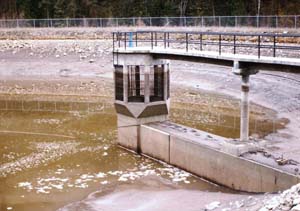 |
| Water Intake on Hadden Resevoir |
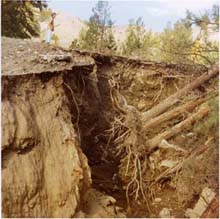 |
In October of 1973, BMID also experienced the failure of the conveyance conduit from Mission Creek. The concrete structure was washed out when the bearing materials below the conduit were washed away. The rebuilding took several weeks of work and resulted in a maintenance program for maintaining the ditches and safe flowpaths for water over the conduit. In 1979, the Scotty Creek Improvement District was amalgamated with BMID to become part of the District. BMID took over the assets and water supply for the irrigation and domestic connections in the Ellison area. |
1980 to Present
The years from 1980 to the present have seen a transition of BMID from primarily an agricultural district to a full-fledged domestic water supplier. The number of connections during this period rose from 1500 connections in early 1980s to over 7100 connections today.
In 1985, BMID purchased the Gopher Flats property for the sum of $98,000. The land is 320 acres in size and the site for the future Black Mountain Reservoir and treatment facility.
In 1987, BMID experienced a waterborne disease outbreak of Giardia that was determined to originate from the water supply on Mission Creek. The chlorine disinfection was upgraded in the next year and a new gas chlorinator was constructed at the outlet from Hadden Reservoir. The added chlorine contact time resulted in the control of Giardia. However, the water quality during the spring still deteriorated with cloudiness and colour in the water.
| In 1990, a new gas chlorinator was also constructed at the Scotty Creek source. In 1993, Stevens Reservoir was constructed to assist in settling of the water from Mission Creek. Although it reduced the silt in the water, the colour was not controlled. |
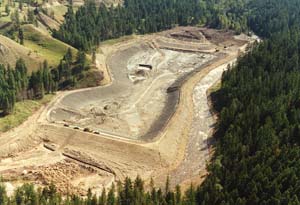 |
 |
The spring of 1997 saw the highest runoff in history into Okanagan Lake. 1996 was an extremely wet year and the watersheds were saturated. A heavy snowpack collected in the watersheds over the winter, and during the spring runoff of 1997, there was very little ground infiltration and high surface runoff. This resulted in 6 natural landslides along Mission Creek. The worst one, on the morning of May 31, 1997 blocked off the creek completely for a short period of time and endangered the lower bridges on Mission Creek at KLO and Casorso Roads. The cloud of silt in the water at the mouth of Mission Creek is shown on the photo (courtesy Brian Symonds, MoWLAP, Penticton ) The event resulted in the realization that although the watershed was properly managed and the forest licensees were respecting all of the laws and controls in place, natural events would create water quality events such as this that could not be controlled. |
In 1998, the water in Mission Creek was piloted through the spring and in mid 1999, construction of the BMID water treatment plant began. The plant provides clarification through a coagulation / flocculation / sedimentation process. The process neutralizes the charge of the suspended particles in the water, including those causing the colour, and then settles the particles out in large open basins. The project was extremely cost effective with a 105 ML/day water treatment plant being constructed for $3,500,000. The plant has resulted in BMID meeting the Guidelines for Canadian Drinking Water Quality year round.
